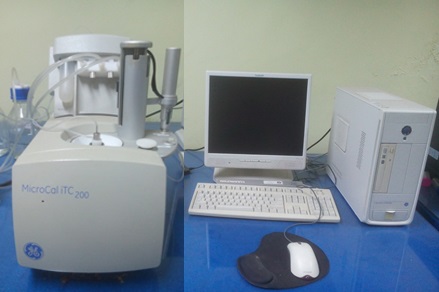- APPLY FOR SLOT
- Internal Users
- External Users
- SLOT BOOKING STATUS
Isothermal Titration Calorimetry Laboratory

Phone : +91-3222-283306
Location : NB / FF / 9, CRF
Facilitator :
Prof. Swagata Dasgupta, Chemistry
Email: swagata@chem.iitkgp.ac.in, Contact:+91-3222-283306
For Internal Users - Click Here to apply for Slot
For External Users - Click Here to apply for Slot
Objectives
Isothermal Titration Calorimetry (iTC200 System): iTC200 is used for characterization of molecular interactions of small molecules, proteins, antibodies, nucleic acids, lipids and other biomolecules. Enzyme kinetics, assessment of the effect of molecular structural changes on binding mechanisms, assessment of biological activities is also possible. Direct measure of sub-millimolar to nanomolar binding constants (102 to 109 M-1) and measurement of nanomolar to picomolar binding constants (109 to 1012 M-1) using the competitive binding technique.
People

Prof. Swagata Dasgupta
Facilitator
Chemistry
swagata@chem.iitkgp.ac.in
+91-3222-283306

Mr. Bidhan Chandra Sing
Technical Staff
Central Research Facility
bidhanbotany@gmail.com
+91-3222-282486
Equipment Details
Isothermal Titration Calorimeter
ITC200 MicroCalorimeter
- Ultrasensitive ITC200 MicroCalorimetry cell with syringe tower
- Control unit for real-time operation and post-run data analysis
- ITC200 washing module for cleaning cell and syringe
- Injection syringes (Hamilton Syringe)
Technical specifications
- Operating Temperature Range: 2 - 80°C
- Response Time: 10 seconds
- Cell Design (volume required): 200μL
- Titration Syringe: 40μL
- Smallest Injection Size: 0.1μL
- Sensitivity range: <0.5 nanocalories (~2 nJ)
Manufacturer details: ITC200 MicroCalorimeter
Malvern Instruments Ltd.
Enigma Business Park,Grovewood Road, Malvern,
Worcestershire, WR14 1XZ, UK
Tel: +44 (0)1684 892456 Fax: +44 (0)1684 892789
system.orders@malvern.com
Date of installation: 10th August, 2012
Utility and Working Principal
Isothermal Titration Calorimetry (ITC) is a well-known analytical technique that can effectively used for investigating the thermodynamic properties of the interaction of macromolecules, small molecules etc. The basic principle of ITC is very simple. It basically measures the heat change (that is either released or absorbed) during a biomolecular binding event. The instrument consists of two cells. One is reference cell which contains water or buffer and other one is sample cell which contains the sample. It is important to keep these both cells at exactly the same temperature. The heat sensing devices detect temperature difference between the cells when binding occurs and give feedback to the heaters, which compensate for this difference and return the cells to equal temperature.
Sample Details
Sample preparation
- ~300 μL of protein sample is required for sample cell and ~40 μL of ligand solution is required for syringe
- The buffers in both the sample cell and the titration syringe should be same to avoid the heat of dilution.
- Typical starting concentrations are 10-50 μM for the cell and 50-500 μM for the syringe
- Syringe concentration ideally 10 x higher than molar concentration of protein in cell, 7 x higher for very tight binding, 15 -20 x higher (or more) for weak binding (Since the syringe volume is ~ 5 fold the cell volume, a 10 fold excess in the syringe will give a final ~ 2 fold excess in the cell)
Precautions:
- Flammable liquids should be avoided
- Strong acids, detergents and organic solvents should be avoided
- Operator should follow proper laboratory procedures in handling and disposing of volatile or hazardous solutions
